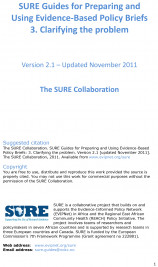SURE Guide 3 is part of the SURE Guides for Preparing and Using Evidence-Based Policy Briefs. The SURE Guides are intended for those people responsible for preparing and supporting the use of policy briefs and ensuring that decisions about health systems are well-informed by research evidence. The guides focus specifically on these issues in the context of African health systems and the examples used are taken from policy briefs that address important problems in African countries.
SURE Guide 3 focuses on the first step of preparing a policy brief, which is to clarify the problem that it will address. Often such problems are unclear when they are first brought to attention. Clarification is therefore essential but if it is done too rapidly, or in a cursory way, it may lead to: focusing on a problem that is not important or not perceived to be important by key stakeholders; considering inappropriate solutions; and failing to consider appropriate solutions
Clarifying how the problem came to attention, how it has been framed, the size of the problem, and the cause of the problem, can help to ensure that the problem warrants attention and that appropriate options for addressing the problem are considered.
SURE Guide 3 provides guidance and resources to answer the following questions that will help to clarify the problem that a policy brief addresses:
• What is the problem and how did it come to attention?
• How has the problem been framed (described) and what are the consequences of this framing?
• How big is the problem?
• What is the cause of the problem?



